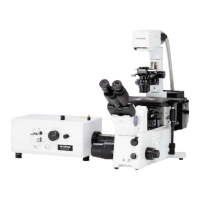Getting Started FLUOVIEW/Basic Operations
IV.
OPERATION INSTRUCTIONS
IV .
1-3
Page
(2) Detection mode setting
The detection modes can be switched over by pushing or pulling the DETECTION
MODE slider (2).
This switch allows you to set the detection mode of the 2 or 1 fluorescence channel
by selecting one of the 3 positions. It switches section A shown in Fig. (I) on the
next page.
x When the slider switch is in the pushed-in position
The mirror is engaged in the light path as shown in Fig. (I) on the next page. As a
result, 100% of the fluorescence is introduced in CH1 (PM1).
Use this mode when observing a fluorescence specimen having a spectral
characteristic with a shorter wavelength than 570 nm, such as FITC.
x When the slider switch is pushed-in half way to the position
The custom dichromatic mirror for separating the fluorescence emission is
engaged in the light path as shown in Fig. (II) on the next page. This dichroic
mirror reflects light with wavelengths shorter than about 570 nm and transmits
light with longer wavelengths. As a result, it can separate fluorescence into CH1
(PM1) and CH2 (PM2).
Use this mode when observing a double-labeled specimen such as
FITC+TRITC.
x When the slider switch is in the pulled-out position
Nothing is engaged in the light path as shown in Fig. (III) on the next page. As a
result, 100% of the fluorescence is introduced in CH2 (PM2).
Use this mode when observing a fluorescence specimen having a spectral
characteristic with a wavelength longer than 570 nm, such as TRITC.

